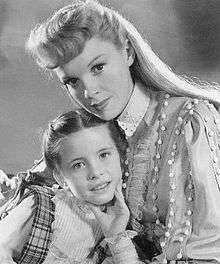Meet Me in St. Louis
| Meet Me in St. Louis | |
|---|---|
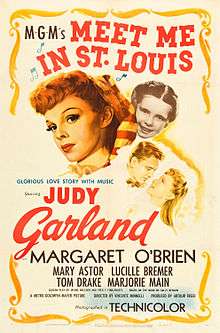 Theatrical poster | |
| Directed by | Vincente Minnelli |
| Produced by | Arthur Freed |
| Screenplay by |
Irving Brecher Fred F. Finklehoffe |
| Based on |
Meet Me in St. Louis by Sally Benson |
| Starring |
Judy Garland Margaret O'Brien Mary Astor Lucille Bremer Tom Drake Marjorie Main |
| Cinematography | George J. Folsey |
| Edited by | Albert Akst |
Production company | |
| Distributed by | Loew's, Inc. |
Release date |
|
Running time | 113 minutes |
| Country | United States |
| Language | English |
| Budget | $1,885,000[2] |
| Box office |
$6,566,000 (original release) $12,800,000[3] |
Meet Me in St. Louis is a 1944 American musical film made by Metro-Goldwyn-Mayer. Divided into a series of seasonal vignettes, starting with Summer 1903, it relates the story of a year in the life of the Smith family in St. Louis, leading up to the opening of the Louisiana Purchase Exposition (more commonly referred to as the World's Fair) in the spring of 1904.[4][5] The picture stars Judy Garland, Margaret O'Brien, Mary Astor, Lucille Bremer, Tom Drake, Leon Ames, Marjorie Main, June Lockhart, and Joan Carroll.
The film was adapted by Irving Brecher and Fred F. Finklehoffe from a series of short stories by Sally Benson, originally published in The New Yorker magazine under the title "5135 Kensington", and later in novel form as Meet Me in St. Louis. The film was directed by Vincente Minnelli, who met Garland on the set and later married her. It was the second-highest grossing picture of the year, only behind Going My Way.[6] In 1994, the film has been deemed "culturally significant" by the Library of Congress and selected for preservation in the United States National Film Registry.
Garland debuted the standards "The Trolley Song", "The Boy Next Door", and "Have Yourself a Merry Little Christmas", all of which became hits after the film was released. Arthur Freed, the producer of the film, also wrote and performed one of the songs.
Plot
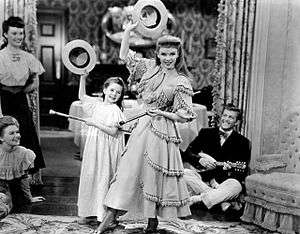
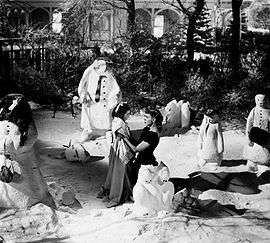
The backdrop for Meet Me in St. Louis is St. Louis, Missouri in the year leading up to the 1904 World's Fair.
It is summer 1903. The Smith family leads a comfortable upper-middle class life. Alonzo Smith (Leon Ames) and his wife Anna (Mary Astor) have four daughters: Rose (Lucille Bremer), Esther (Judy Garland), Agnes (Joan Carroll), and Tootie (Margaret O'Brien); and a son, Lon Jr. (Henry H. Daniels, Jr.). Esther, the second eldest daughter, is in love with the boy next door, John Truett (Tom Drake), although he does not notice her at first. Rose is expecting a phone call during which she hopes to be proposed to by Warren Sheffield (Robert Sully), and is embarrassed when not only does Warren fail to propose, but the entire family is present as she takes the call during dinner.
Esther finally gets to meet John properly when he is a guest at the Smiths' house party, although her chances of romancing him don't go as planned when, after all the guests are gone and he is helping her turn off the gas lamps throughout the house, he tells her she uses the same perfume as his grandmother and that she has "a mighty strong grip for a girl."
Esther hopes to meet John again the following Friday on a trolley ride from the city to the construction site of the World Fair. Esther is sad when the trolley sets off without any sign of him, but cheers up when she sees him running to catch the trolley mid journey.
On Halloween, Tootie returns home injured, claiming that John Truett attacked her. Without bothering to investigate, Esther confronts John, physically attacking him and scolding him for being a "bully." When Esther returns home, Tootie confesses that what really happened was that John was trying to protect Tootie and Agnes from the police after a dangerous prank they pulled went wrong. Upon learning the truth, Esther immediately dashes to John's house next door to apologize, and they share their first kiss.
Mr. Smith announces to the family that he is to be sent to New York City on business and they will all move after Christmas. The family is devastated and upset at the news of the move, especially Rose and Esther whose romances, friendships, and educational plans are threatened. Esther is also aghast because they will miss the World's Fair.
An elegant ball takes place on Christmas Eve. Esther is devastated when John cannot take her as his date, due to his leaving his tuxedo at the tailor's and being unable to get it back. She is relieved, however, when her grandfather (Harry Davenport) offers to take her to the ball instead. At the ball, Esther and Rose plot to ruin the evening of Warren's date and Rose's rival Lucille Ballard (played by June Lockhart) by filling up her dance card with losers. But when Lucille turns out to be interested in Lon, leaving Rose and Warren together, Esther switches her dance card with Lucille's and instead dances in Lucille's place with the clumsy and awkward partners. After being rescued by Grandpa, Esther is overjoyed when John unexpectedly turns up after somehow managing to obtain a tuxedo, and the pair dance together for the rest of the evening. Later on, John proposes to Esther and she accepts, but their future is uncertain because she must still move to New York.
Esther returns home to an upset Tootie. She is soothed by the poignant "Have Yourself a Merry Little Christmas". Tootie, however, becomes more upset at the prospect of the family's move and runs downstairs, out into the cold to destroy the snowmen they have made. Mr. Smith sees his daughter's upsetting outburst from an upstairs window.
Mr. Smith later announces that the family will not leave St. Louis after all when he realizes how much the move will affect his family. Warren boldly declares his love for Rose, stating that they will marry at the first possible opportunity.
On or after April 30, 1904, the family take two horse drawn buggies to the World's Fair. The film ends that night with the entire family (including John, Lucille, and Warren) overlooking the Grand Lagoon at the center of the World's Fair just as thousands of lights illuminate the grand pavilions.
Cast
- Judy Garland as Esther Smith
- Margaret O'Brien as "Tootie" Smith
- Mary Astor as Mrs. Anna Smith
- Leon Ames as Mr. Alonzo Smith
- Lucille Bremer as Rose Smith
- Tom Drake as John Truett
- Marjorie Main as Katie the maid
- Harry Davenport as Grandpa
- Henry H. Daniels Jr. as Alonzo "Lon" Smith Jr.
- Joan Carroll as Agnes Smith
- June Lockhart as Lucille Ballard
- Robert Sully as Warren Sheffield
- Hugh Marlowe as Colonel Darly
- Chill Wills as Mr. Neely the iceman
Music
The musical score for the film was adapted by Roger Edens, who also served as an uncredited associate producer. Georgie Stoll conducted the orchestrations of Conrad Salinger. Some of the songs in the film are from around the time of the St Louis Exposition. Others were written for the movie.
- "Meet Me in St. Louis, Louis" Kerry Mills and Andrew B. Sterling, 1904
- "The Boy Next Door", Hugh Martin and Ralph Blane, 1944, performed by Judy Garland.
- "Skip to My Lou", Traditional, with section sung to the tunes of "Kingdom Coming" and "Yankee Doodle" arranged by Hugh Martin and Ralph Blane, 1944
- "I Was Drunk Last Night," performed by Margaret O'Brien.
- "Under the Bamboo Tree," Words and music by Robert Cole and The Johnson Bros., 1902, performed by Judy Garland and Margaret O'Brien.
- "Over the Banister," 19th-century melody adapted by Conrad Salinger, lyrics from the 1888 poem "Over the Banisters" by Ella Wheeler Wilcox, adapted by Roger Edens (1944), performed by Judy Garland.
- "The Trolley Song", Hugh Martin and Ralph Blane, 1944, performed by Chorus and Judy Garland.
- "You and I," Nacio Herb Brown and Arthur Freed, sung by Arthur Freed and D. Markas, dubbing for Leon Ames and Mary Astor.
- "Goodbye, My Lady Love", (Instrumental), Joseph E. Howard, 1904.
- "Little Brown Jug", (Instrumental), Joseph Winner, 1869.
- "Down at the Old Bull and Bush," (Instrumental), Harry von Tilzer, 1903.
- "Home! Sweet Home!", (Instrumental), Henry Bishop, 1823/1852.
- "Auld Lang Syne", (Instrumental)
- "The First Noel", (Instrumental)
- "Have Yourself a Merry Little Christmas", Hugh Martin and Ralph Blane, 1944, performed by Judy Garland. The lyrics for "Have Yourself A Merry Little Christmas" were originally different. The lyricist, Hugh Martin, wrote opening lyrics which were deemed too depressing by Judy Garland, Tom Drake, and Vincente Minnelli (They were: "Have yourself a merry little Christmas / It may be your last/ Next year we may all be living in the past"), so Martin changed the lyrics.
- (Years after the movie's release, additional lyric changes were made for Frank Sinatra, who objected to the song's generally downbeat tone. The most notable changes included "Next year" becoming "From now on", "Once again, as in olden days / Happy golden days of yore / Faithful friends that were dear to us / Will be near to us once more" becoming "Here we are, as in olden days / Happy golden days of yore / Faithful friends that are dear to us / Gather near to us once more", and "Someday soon we all will be together / If the fates allow / Until then we'll just have to muddle through somehow" becoming "Through the years we all will be together / If the fates allow / Hang a shining star upon the highest bough". This revised version is the one now most commonly performed.)
Deleted song
Judy Garland pre-recording of "Boys and Girls Like You and Me" for this film survives today, but the film footage has been lost.[7]
Reception
Upon its 1944 release, Meet Me in St. Louis was a massive critical and commercial success. During its initial theatrical release, it earned a then-massive $5,016,000 in the US and Canada and $1,550,000 elsewhere resulting in a profit of $2,359,000.[2]
Time called it "one of the year's prettiest pictures"; "Technicolor has seldom been more affectionately used than in its registrations of the sober mahoganies and tender muslins and benign gaslights of the period. Now & then, too, the film gets well beyond the charm of mere tableau for short flights in the empyrean of genuine domestic poetry. These triumphs are creditable mainly to the intensity and grace of Margaret O'Brien and to the ability of director Minnelli & Co. to get the best out of her."[8] O'Brien drew further praise from Time; " [her] song and her cakewalk done in a nightgown at a grown-up party, are entrancing acts. Her self-terrified Halloween adventures richly set against firelight, dark streets, and the rusty confabulations of fallen leaves, bring this section of the film very near the first-rate." The film is a New York Times Critics' Pick: after seeing it at the Astor Theatre, Bosley Crowther called it "a warm and beguiling picturization based on Sally Benson's memoirs of her folks."[9] Crowther concludes: "As a comparable screen companion to Life With Father, we would confidently predict that Meet Me in St. Louis has a future that is equally bright. In the words of one of the gentlemen, it is a ginger-peachy show." Writing in The New Yorker, Wolcott Gibbs praised the film as "extremely attractive" and called the dialogue "funny in a sense rather rare in the movies," although he thought it was too long.[10]
In 2005, Richard Schickel included the film on Time.com's ALL-TIME 100 best films, saying "It had wonderful songs [and] a sweetly unneurotic performance by Judy Garland....Despite its nostalgic charm, Minnelli infused the piece with a dreamy, occasionally surreal, darkness and it remains, for some of us, the greatest of American movie musicals."[11]
Arthur Freed: "Meet Me in St. Louis is my personal favourite. I got along wonderfully with Judy, but the only time we were ever on the outs was when we did this film. She didn't want to do the picture. Even her mother came to me about it. We bumped into some trouble with some opinions – Eddie Mannix, the studio manager, thought the Halloween sequence was wrong, but it was left in. There was a song that Rodgers and Hammerstein had written, called Boys and Girls Like You and Me, that Judy did wonderfully, but it slowed up the picture and it was cut out. After the preview of the completed film, Judy came over to me and said, "Arthur remind me not to tell you what kind of pictures to make. " [It] was the biggest grosser Metro had up to that time, except for Gone With the Wind."[12]
The film currently holds a 100% "Fresh" rating on the review aggregate website Rotten Tomatoes, based on 30 critical reviews with an average score of 8.7/10.[13]
Accolades
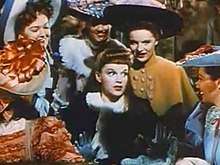
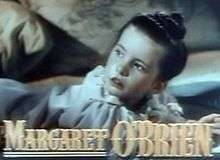
The film was nominated for four Academy Awards: Best Writing, Adapted Screenplay, Best Cinematography, Color, Best Music, Scoring of a Musical Picture, and Best Music, Song (Ralph Blane and Hugh Martin for "The Trolley Song"). Margaret O'Brien received an Academy Juvenile Award for her work that year, in which she appeared in several movies along with Meet Me in St. Louis.
In 1994, the film has been deemed "culturally significant" by the Library of Congress and selected for preservation in the United States National Film Registry.
The American Film Institute ranked the film 10th on AFI's Greatest Movie Musicals; two songs from the film made AFI's 100 Years...100 Songs ("The Trolley Song" at #26 and "Have Yourself a Merry Little Christmas" at #76).
Gerald Kaufman wrote a study of the film, with the same title, which was published by the British Film Institute in 1994.
Adaptations
- Meet Me in St. Louis was remade in 1959 for television, starring Jane Powell, Jeanne Crain, Patty Duke, Walter Pidgeon, Ed Wynn, Tab Hunter and Myrna Loy. It was directed by George Schaefer from the original Brecher and Finklehoffe screenplay.
- Meet Me in St. Louis was remade again for television in 1966. This was a non-musical version starring Shelley Fabares, Celeste Holm, Larry Merrill, Judy Land, Reta Shaw, Tammy Locke and Morgan Brittany. It was directed by Alan D. Courtney from a script written by Sally Benson herself. This was to be a pilot for a TV series, but no network picked it up. It was later included as a special feature on the 2 disc DVD set released in 2004.
- A Broadway musical based on the film was produced in 1989, with additional songs.
The late-19th century vintage carousel in this movie could be found at Bob-Lo Amusement Park in Amherstburg, Ontario until the park closed in September 1993. It was dismantled and sold to private collectors.
Movie references
- The Family Stone (2005) shows two partial scenes from the movie; one where Esther and John dance, and another where Esther sings "Have Yourself a Merry Little Christmas" to Tootie.
- Deck the Halls (2006) shows Steve (Matthew Broderick) watching the scene where Esther sings "Have Yourself a Merry Little Christmas" to Tootie and she bashes the snowmen. Steve is depressed that his family left him and watching this scene in the film makes him only more upset.
- Sex and the City (2008) shows Carrie's (Sarah Jessica Parker) assistant, Louise from St. Louis, give her a DVD of the film as a Christmas gift, and later shows Carrie watching a bit of "The Trolley Song". The film is also divided into a series of seasonal vignettes following the same format as Meet Me in St. Louis.
References
- ↑ "Meet Me in St. Louis". American Film Institute. Retrieved February 28, 2016.
- 1 2 The Eddie Mannix Ledger, Los Angeles: Margaret Herrick Library, Center for Motion Picture Study
- ↑ Box Office Information for Meet Me in St. Louis. The Numbers. Retrieved August 27, 2013.
- ↑ Variety film review; November 1, 1944, page 10.
- ↑ Harrison's Reports film review; November 4, 1944, page 178.
- ↑ "Movies: Top 5 Box Office Hits, 1939 to 1988". Ldsfilm.com. Retrieved 2014-06-18.
- ↑ Judy Garland's pre-recording of "Boys and Girls Like You and Me" on YouTube
- ↑ "The New Pictures". TIME. November 27, 1944. Retrieved 2011-08-02.
- ↑ Crowther, Bosley (November 29, 1944). "Meet Me in St. Louis, a Period Film That Has Charm, With Judy Garland and Margaret O'Brien, Opens at the Astor". The New York Times. Retrieved 2011-08-02.
- ↑ Gibbs, Wolcott (December 9, 1944). "The Current Cinema". The New Yorker. New York: F-R Publishing Corp.: 50.
- ↑ Schickel, Richard (February 12, 2005). "Meet Me in St. Louis (1944)". TIME. Retrieved 2011-08-02.
- ↑ Films of Judy Garland, Joe Morella & Edward Epstein Cadillac Publishing, 1969
- ↑ Movie Reviews for Meet Me in St. Louis. Rotten Tomatoes. Retrieved August 27, 2013.
External links
- Meet Me in St. Louis on IMDb
- Meet Me in St. Louis at the TCM Movie Database
- Meet Me in St. Louis at AllMovie
- Meet Me in St. Louis at Rotten Tomatoes
- Meet Me in St. Louis from TheJudyRoom.com
- Meet Me in St. Louis at Filmsite.org.
- Meet Me in St. Louis at the Museum of Modern Art.
- Meet Me in St. Louis on Lux Radio Theater: December 2, 1946
